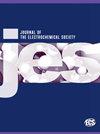Indole-3-Carbinol Upconversion with Copper Oxide Nanoparticles Supported Graphitic Carbon Nitride: A Sustainable Approach
IF 3.3
4区 工程技术
Q2 ELECTROCHEMISTRY
引用次数: 0
Abstract
Electro-organic chemistry offers a sustainable and efficient approach to organic synthesis by utilizing electrochemical processes. This field has gained significant attention due to its potential for minimizing waste, reducing energy consumption, and enabling selective transformations. Herein, we report the development of a graphitic carbon nitride-coated carbon fiber electrode modified with electropolymerized amino-2-thiazole and electrodeposited Cu2O nanoparticles from copper nitrate trihydrate for the oxidation of Indole-3-carbinol (IC). Scanning electron microscopy, X-ray diffraction analysis, and X-ray photoelectron spectroscopy studies were carried out to characterize the developed electrode. Cyclic voltammetry, electrochemical impedance spectroscopy, and bulk electrolysis techniques were employed for the electrochemical studies. The enhanced electrochemical activity of the Cu2O-pAT-GCN-TCFP electrode compared to the individual GCN and polymer electrode was studied using electrochemical characterization, which revealed a 3-fold increase in the current response for Cu2O-pAT-GCN-TCFP (0.0011 A) compared to the bare electrode. The reaction was carried out using an aqueous carbonate buffer solution as an electrolyte via bulk electrolysis at a set potential of 0.82 V. The product obtained was isolated by column chromatography to obtain a yield of 74% and characterized by proton nuclear magnetic resonance (1H NMR) spectroscopy. Additionally, the Cu2O-pAT-GCN-TCFP electrode was studied for its stability, reproducibility, and selectivity.以氮化石墨碳为支撑的氧化铜纳米颗粒实现吲哚-3-卡比醇的上转换:一种可持续的方法
电有机化学利用电化学过程为有机合成提供了一种可持续的高效方法。这一领域因其在减少废物、降低能耗和实现选择性转化方面的潜力而备受关注。在此,我们报告了用电解聚合氨基-2-噻唑修饰的氮化石墨碳涂层碳纤维电极和从三水硝酸铜中电沉积的 Cu2O 纳米粒子的开发情况,该电极用于氧化吲哚-3-甲醇(IC)。对所开发的电极进行了扫描电子显微镜、X 射线衍射分析和 X 射线光电子能谱研究。电化学研究采用了循环伏安法、电化学阻抗光谱法和体液电解技术。通过电化学表征研究发现,与单独的 GCN 和聚合物电极相比,Cu2O-pAT-GCN-TCFP 电极的电化学活性增强了,与裸电极相比,Cu2O-pAT-GCN-TCFP 的电流响应增加了 3 倍(0.0011 A)。反应以碳酸盐缓冲水溶液为电解质,在 0.82 V 的设定电位下通过体电解进行。通过柱层析分离得到的产物收率为 74%,并通过质子核磁共振 (1H NMR) 光谱进行表征。此外,还对 Cu2O-pAT-GCN-TCFP 电极的稳定性、再现性和选择性进行了研究。
本文章由计算机程序翻译,如有差异,请以英文原文为准。
求助全文
约1分钟内获得全文
求助全文
来源期刊
CiteScore
7.20
自引率
12.80%
发文量
1369
审稿时长
1.5 months
期刊介绍:
The Journal of The Electrochemical Society (JES) is the leader in the field of solid-state and electrochemical science and technology. This peer-reviewed journal publishes an average of 450 pages of 70 articles each month. Articles are posted online, with a monthly paper edition following electronic publication. The ECS membership benefits package includes access to the electronic edition of this journal.

 求助内容:
求助内容: 应助结果提醒方式:
应助结果提醒方式:


